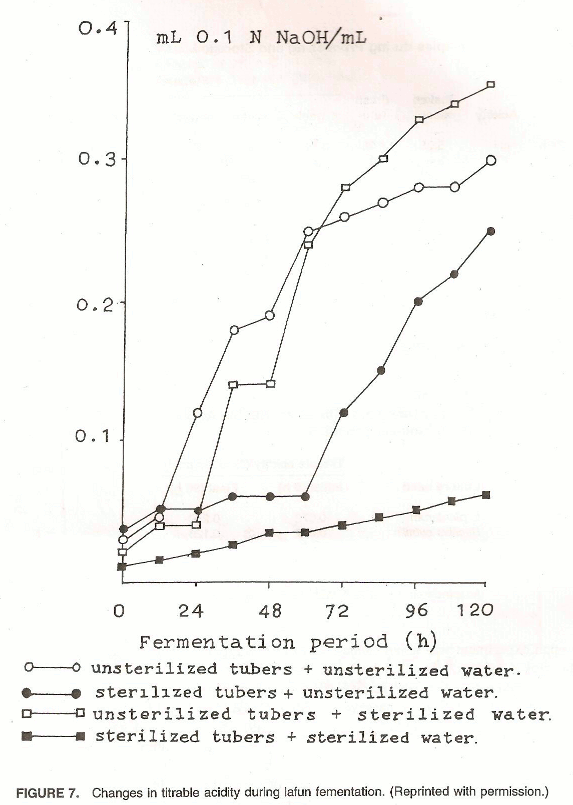Cassava Fermentation and Associated Changes in Physicochemical and Functional Properties
Prev Page | Next PageC. Organic Acids
The microorganisms present in the fermenting medium convert starch and sugars in the tubers to organic acids, which impart the characteristic odour and taste to the different fermented products. Although lactic acid is one of the common acids reported in almost all types of fermentation (Table 11), many short and long chain acids, esters, aldehydes, etc. have been detected and quantified by GLC and HPLC.
While only lactic acid was reported in gari by Akinrele,14 a number of other acids have been reported in detailed studies on gari prepared using different cultures as well as natural fermentation. The flavor components were analyzed by GLC and the organisms properties by a ten-member taste panel. Formate, acetate, propionate, isobutyrate, n-butyrate, methyl acetate, methyl propionate, methyl lactate, methyl isobutyrate, methyl-n-butyrate, methyl succinate and dimethyl oxalate were found both in mash and probably driven off during frying into gari. Methyl lactate was present, whereas methyl-n-butyrate was absent in the most acceptable samples. The organic acid content in gari produced using irradiated cassava inoculated with homofermentative Lactobacillus plantarum, heterofermentative Lactobacillus brevis, and with natural microflora was examined.46 Among other results the disappearance of malate from natural fermentation and that inoculated with L.brevis has been explained as due to malolactic fermentation.
Changes in pH during pit Fermentation

Table 11: Organic Acids in Different Fermented Products
| Product | Organic acids | Ref |
|---|---|---|
| Gari | Lactic | 14 |
| Gari | Lactic, succinic, oxalic | 69 |
| Gari | Acetic, Lactic, propionic, succinic, pyruvic, isobutyric, n-butyric, Mystric , palmitic, stearic, oleic, linoleic, linolenic | 47 |
| Gari | Lactic, Acetic, malic and succinic | 16 |
| Gari | Lactate, acetate, n-butyrate, isobutyrate, methyl lactate, methyl acetate, methyl propionate, dimethyl succinate | 29 |
| Gari | Lactic, Acetic | 57 |
| Fufu | Acetic, butyric, isobutyric | 15 |
| Fufu | Butyric | 70 |
| Fufu | Acetic, butyric, propionic, isobutyric, butyric, valeric, isovaleric | 49 |
| Fufu | Butanoic, propionic, acetic | 71 |
| Fufu | Acetic, propionic, butyric | 72 |
| Chikwangue | Butyrate | 70 |
| Farinha | Oxalic, malic, citric, succinic, lactic | 69 |
| Fermented | Propionic, butyric, acetic, formic, succinic, lactic | 73 |
| Fermenting Mash | Lactic, formic | 14 |
| Sour starch | Lactic, Acetic, butyric | 74 |
The flavoring constituents in gari and farinha have been quantified by GLC.69 The organic acids were found to be the most important flavoring constituent in gari. Lactic acid was present in gari but negligible in farinha. Another interesting observation was the presence of a large amount of oxalic acid in farinha when compared with gari. The presence of succinic acid in detectable levels in both products suggested that it is a fermentation product. The compounds constituting the odour components were similar for both gari and farinha, but pyrazone peaks from gari were larger and more numerous. These might have been formed by Maillard reaction between the amino acids and sugars. Another compound found only in gari was Stachene. A number of aldehydes, ketones and alcohols were identified in both gari and farinha. Furfural, 3-Methylbutan-1-al,trans-trans and trans-cis isomers of deca2, 4-dienal, and nonalol were present only in gari.
Butanoic acid production during fufu fermentation was considered to be responsible for yhe objectionable odour.71 In fufu, nearly equal quantities of acetic, butyric, and isobutyric acids were detected.15 The main organic acids in farinha were oxalic, malic, and citric acid is attributed to the action of Corynebacterium.
Oxalate reportedly present to an extent of 3.2% in cassava tubers was reduced to 1.2% during Lafun preparation.38 In fufu and chickwangue, ethanol, lactate, butyrate, acetate, and propionate were produced in that order of importance and whereas butyrate and acetate gradually increased throughout the fermentation, lactate, propionate, and ethanol reached their maximum on the second and third day of fermentation and then decreased.70 The high content of butyrate in Chickwangue and fufu may be responsible for the characteristic flavor.
The changes in fatty acids during production of fermented cassava meal have been elaborated.75 The fatty acids present in cassava eal viz. linoleic, linolenic, palmitoleic, stearic, myristric, pentadecanoic, heptadecanoic, nonadecanoic acids underwent a substantial increase in the absolute quantities, except linolenic acid. The saturated fatty acids such as stearic acid and pentadecanoic acid were enhanced, while unsaturated ones such as linolenic and palmitolenic acids were reduced. Studies on the development of flavor during fermentation revealed that ethanol might be contributing by forming esters with the organic acids, while acetaldehyde might not have a direct influence, as it is volatile.76 The presence of diacetyl is explained as due to the action of Streptococcus faecium (Table 12).
Ampe et al. compared different conditions in a series of experiments and found that lactate was higher when inoculum was used.49 Although butyrate appeared to be important in fufuf quality, no correlation between the volatile fatty acids in the mash and fufu quality could be established. Varietal difference and root size had no effect on organic acid pattern, while peeling before retting reduced acetate production. Butyrate content increased slightly between 320C to 370C and the most suitable organism for butyrate production was Clostrodium butyricum. The lipid content in starch and flour extracted from tubers subjected to natural and inoculum provided fermentations was invariably reduced.67 It was also suggested that complexation of the souble amylase portion with the organic acids formed during fermentation modified the starch properties.72 Cereda has found that the amount of lactic acid in fermented cassava samples could be considered an index of the water absorption capacity.16


